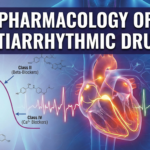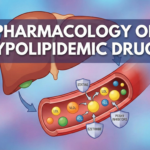I. Introduction and Class Overview
Carbonic anhydrase inhibitors (CAIs) are a class of drugs that reversibly inhibit the enzyme carbonic anhydrase, thereby interfering with HCO₃⁻ (bicarbonate) reabsorption and decreasing hydrogen ion secretion in several tissues. Their major clinical uses are as diuretics, in the management of glaucoma, acute mountain sickness, certain epilepsies, and as adjuncts in treating alkalosis.
Key drugs:
- Acetazolamide (prototypical, oral and IV)
- Dorzolamide, brinzolamide (topical ocular for glaucoma)
- Methazolamide (longer acting, oral)
- Others: Dichlorphenamide (historically); ethoxzolamide (rare, research)
II. Carbonic Anhydrase and Physiological Role
Carbonic anhydrase is a zinc-containing enzyme present in almost all tissues. Key roles:
- Catalyzes reversible hydration of carbon dioxide: CO2+H2O⇌H2CO3⇌H++HCO3−CO2+H2O⇌H2CO3⇌H++HCO3−
- Major locations: Proximal renal tubule, red blood cells, eye (ciliary body), gastric mucosa, CNS (choroid plexus), others.
III. Mechanism of Action
A. Renal (Diuretic) Effects
- Inhibition of proximal tubular carbonic anhydrase reduces the availability of H+ for Na+/H+ exchange and decreases bicarbonate reabsorption.
- Enhanced NaHCO₃, K⁺, and water excretion; urine becomes alkaline.
- Diuretic effect is modest and self-limited due to downstream compensation (distal nephron increases Na⁺ reabsorption in exchange for K⁺ and H⁺).
B. Ocular Effects
- In the ciliary body, CA inhibition reduces aqueous humor production by lowering HCO₃⁻ transport.
- Topical CAIs lower intraocular pressure (IOP) in open-angle glaucoma.
C. CNS/Other Tissues
- Decreased cerebrospinal fluid (CSF) production (uses in elevated intracranial pressure, epilepsy).
- Raises CSF and plasma bicarbonate loss, producing mild metabolic acidosis.
IV. Pharmacokinetics
- Absorption: Acetazolamide, methazolamide: well absorbed orally; onset 1–1.5 hours; peak action 2–4 hours.
- Duration: Acetazolamide ~8–12 hours; methazolamide longer (due to more lipid solubility).
- Elimination: Mostly renal; dose reduction in renal impairment is required.
- Topical agents (dorzolamide, brinzolamide): Minimal systemic absorption and effect.
V. Therapeutic Uses
A. Glaucoma (main current use):
- Acetazolamide (oral/IV): For acute IOP elevation (e.g., acute angle-closure attacks, perioperative)
- Dorzolamide, brinzolamide (topical): For chronic open-angle glaucoma or adjunct in other glaucomas
B. Diuretic (oral/IV):
- Weak, short-term effect—used mostly when urine alkalinization or metabolic alkalosis correction is desired (e.g., drug-induced metabolic alkalosis, cystinuria, uric acid nephropathy for prevention of crystal formation).
C. Acute Mountain Sickness (AMS):
- Prophylaxis and treatment: Increases HCO₃⁻ excretion, mild metabolic acidosis, stimulates respiration, and counteracts hypoxia-induced respiratory alkalosis.
D. Epilepsy:
E. Other uses:
- Decrease CSF production (idiopathic intracranial hypertension).
- Adjunct in familial periodic paralysis (rare).
VI. Adverse Effects
| Adverse Event | Mechanism/Note |
|---|---|
| Metabolic acidosis | Loss of HCO₃⁻, self-limited diuresis |
| Hypokalemia | Enhanced distal K⁺ secretion |
| Renal stone formation | Alkaline urine → ↓Ca²⁺ solubility |
| Drowsiness, paresthesias | CNS/neuromuscular effect |
| Allergic reactions | All are sulfonamides |
| Rare: Hepatic encephalopathy | In cirrhosis—NH₄⁺ retention |
| Taste alterations, GI upset | With oral/topical agents |
| Topical: Ocular discomfort | Dorzolamide, brinzolamide (eye only) |
Contraindications:
VII. Drug Interactions & Precautions
- Potentiates: CNS effects with high-dose salicylates, digoxin toxicity via hypokalemia.
- Decreases renal excretion of: Weak bases (e.g., amphetamines).
- Combination with other diuretics: May potentiate K+ loss.
- Monitor: Electrolytes, acid–base balance, renal function especially in elderly or those with comorbidities.
VIII. Clinical Pearls
- Diuretic use is limited to specialized indications; rapid tolerance develops.
- First-line topical agents in open-angle glaucoma when prostaglandin analogs/beta-blockers are contraindicated or insufficient.
- AMS: Acetazolamide allows climbing to higher altitudes with less risk of AMS by promoting renal HCO₃⁻ loss, decreasing respiratory alkalosis.
- Rarely used for epilepsy due to better alternatives.
- No role in hypertension management.
IX. Comparative Table
| Drug (Formulation) | Systemic Activity | Main Use | Duration | Notable AE |
|---|---|---|---|---|
| Acetazolamide (oral/IV) | Yes | AMS, glaucoma, alkalosis | 8–12 h | Acidosis, K⁺ loss, drowsiness |
| Methazolamide (oral) | Yes | AMS, glaucoma | Up to 18 h | Same as acetazolamide |
| Dorzolamide (topical eye) | Minimal | Glaucoma (adjunct) | 8–12 h | Ocular irritation |
| Brinzolamide (topical eye) | Minimal | Glaucoma (adjunct) | 12 h | Ocular irritation |
X. Key Examination Points
- Mechanism: Reversible inhibition of carbonic anhydrase in proximal renal tubule, ciliary body, choroid plexus.
- Major clinical uses now: Open-angle glaucoma (topical), AMS (systemic), metabolic alkalosis (limited).
- Bonus effect in AMS: Stimulates respiration by producing mild metabolic acidosis.
- Serious AE/risks: Metabolic acidosis, renal stones, hypokalemia. Sulfa allergy risk!
- Not for routine diuresis.
- Contraindicated in hepatic failure: Ammonia retention may worsen encephalopathy.
- Develops tolerance rapidly for diuretic use due to distal nephron compensation; not for long-term edema.
- No longer first-line for epilepsy or as general diuretic.
XI. References
- Brunton LL, Hilal-Dandan R, Knollmann BC, eds. Goodman & Gilman’s The Pharmacological Basis of Therapeutics. 13th ed. New York: McGraw-Hill; 2017. Chapter: Diuretics—Carbonic Anhydrase Inhibitors.
- Katzung BG, Trevor AJ. Basic and Clinical Pharmacology. 15th ed. New York: McGraw-Hill; 2021. Chapter: Diuretic Agents—Carbonic Anhydrase Inhibitors.
- Ritter JM, Flower RJ, Henderson G, et al. Rang & Dale’s Pharmacology. 10th ed. London: Elsevier; 2024. “Drugs affecting renal function.”
📚 AI Pharma Quiz Generator
🎉 Quiz Results
Medical Disclaimer
The medical information on this post is for general educational purposes only and is provided by Pharmacology Mentor. While we strive to keep content current and accurate, Pharmacology Mentor makes no representations or warranties, express or implied, regarding the completeness, accuracy, reliability, suitability, or availability of the post, the website, or any information, products, services, or related graphics for any purpose. This content is not a substitute for professional medical advice, diagnosis, or treatment; always seek the advice of your physician or other qualified health provider with any questions you may have regarding a medical condition and never disregard or delay seeking professional advice because of something you have read here. Reliance on any information provided is solely at your own risk.









